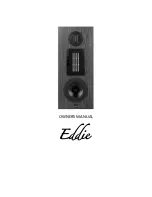
2. Determine the cause of the problem and correct it.
3. Press the STANDBY
/ON button once again, supply the power.
Note:
When the protection circuitry functions, the unit will not operate unless the STANDBY
/ON button is first switched STANDBY
and then ON again.
2 Prevention of Electro Static Discharge (ESD) to
Electrostatically Sensitive (ES) Devices
Some semiconductor (solid state) devices can be damaged easily by electricity. Such components commonly are called
Electrostatically Sensitive (ES) Devices. Examples of typical ES devices are integrated circuits and some field-effect transistors and
semiconductor “chip” components. The following techniques should be used to help reduce the incidence of component damage
caused by electro static discharge (ESD).
1. Immediately before handling any semiconductor component or semiconductor-equiped assembly, drain off any ESD on your
body by touching a known earth ground. Alternatively, obtain and wear a commercially available discharging ESD wrist strap,
which should be removed for potential shock reasons prior to applying power to the unit under test.
2. After removing an electrical assembly equiped with ES devices, place the assembly on a conductive surface such as aluminium
foil, to prevent electrostatic charge build up or exposure of the assembly.
3. Use only a grounded-tip soldering iron to solder or unsolder ES devices.
4. Use only an anti-static solder remover device. Some solder removal devices not classified as “anti-static (ESD protected)” can
generate electrical charge to damage ES devices.
5. Do not use freon-propelled chemicals. These can generate electrical charges sufficient to damage ES devices.
6. Do not remove a replacement ES device from its protective package until immediately before you are ready to install it. (Most
replacement ES devices are packaged with leads electrically shorted together by conductive foam, aluminium foil or
comparable conductive material).
7. Immediately before removing the protective material from the leads of a replacement ES device, touch the protective material
to the chassis or circuit assembly into which the device will be installed.
Caution
Be sure no power is applied to the chassis or circuit, and observe all other safety precautions.
8. Minimize body motions when handling unpackaged replacement ES devices. (Otherwise harmless motion such as the brushing
together of your clothes fabric or the lifting of your foot from a carpeted floor can generate static electricity (ESD) sufficient to
damage an ES device).
3 Handling the Lead Solder
3.1. About Lead Free Solder (PbF)
Distinction of PbF P.C.B. :
P.C.B.s (manufactured) using lead free solder will have a PbF stamp on the P.C.B.
Caution:
·
Pb free solder has a higher melting point that standard solder; Typically the melting point is 50 - 70°F (30 - 40°C) higher.
Please use a high temperature soldering iron. In case of the soldering iron with temperature control, please set it to 700 ± 20°F
(370 ± 10°C).
·
Pb free solder will tend to splash when heated too high (about 1100°F/600°C).
·
When soldering or unsoldering, please completely remove all of the solder on the pins or solder area, and be sure to heat the
soldering points with the Pb free solder until it melts enough.
5
SA-HT40EE
Summary of Contents for SA-HT40EE
Page 7: ...5 Operation Procedures 5 1 Remote Control Operation 7 SA HT40EE ...
Page 8: ...5 2 Main Unit Operation 8 SA HT40EE ...
Page 9: ...9 SA HT40EE ...
Page 10: ...6 1 Music Port 6 New Features 10 SA HT40EE ...
Page 14: ...8 3 Main Parts Location 14 SA HT40EE ...
Page 23: ...9 3 Checking the Panel P C B Music Port P C B and Volume P C B 23 SA HT40EE ...
Page 24: ...9 4 Checking the Main P C B Power P C B Digital Amp P C B 24 SA HT40EE ...
Page 32: ...32 SA HT40EE ...
Page 34: ...SA HT40EE 34 ...
Page 38: ...38 SA HT40EE ...
Page 44: ...SA HT40EE 44 ...
Page 48: ...SA HT40EE 48 ...
Page 50: ...SA HT40EE 50 ...
Page 58: ...SA HT40EE 58 ...
Page 61: ...17 Exploded Views 17 1 Cabinet Parts Location SA HT40EE 61 ...
Page 62: ...17 2 Packaging SA HT40EE 62 ...






































